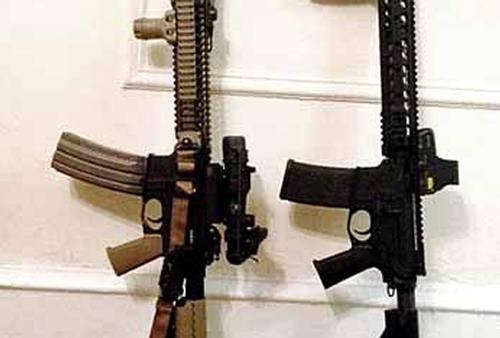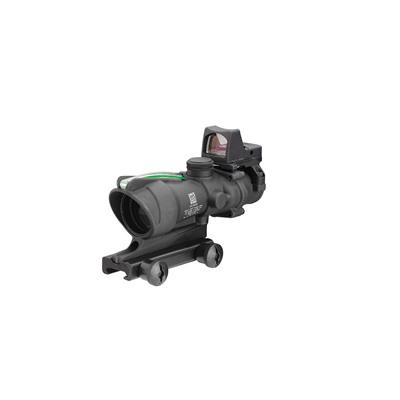With carbines like the AR 15, the SCAR, Tavor, and SIG MCX ruling the market, the need for a quality optic has formed an entire market. The carbine saw a lot of accessories come about due to two events: the expiration of the Federal Assault weapons ban and the War on Terror. As non-neutered AR rifles hit the market there was a great demand for optics specifically designed for a carbine. As the war on terror ramped up, it became apparent that optically enhanced rifles were more effective than rifles with iron sights.
What evolved is two different types of sights, small, reflexive, red dots, and small, fixed magnified optics. Both became quite popular, and different types were adopted by different branches in the military. The U.S. Army adopted the always excellent Aimpoint M4 and later the modified M4S, and the Marine Corps went on to adopt and field the Trijicon Acog.
To make this comparison a fair one—i.e., to answer the question, “Which will win in a battle between Acogs vs Red Dots?”— I’m keeping with high quality red dots and those that meet and exceed military specs. You won’t be seeing the 25-dollar Walmart special here.
Acog
The Trijicon Acog is most often a magnified optic, but some 1x variants do exist. The Acog that was adopted by the Marine Corps is a 4 power optic designed to be used with either the M4 and its shorter barrel or the M16 with its longer barrel. The Acog famously includes an incredibly precise bullet drop compensator that from experience makes hitting man sized targets at 500 yards a breeze.
Red Dot (Aimpoint M4)
Red dots are simple and remarkably easy to use. Brands like Aimpoint introduce a variety of different optics in different sizes, for different missions. However, from the hunter design H-1 to the war fight approved Aimpoint M4s, all of their optics are quality.
Other brands like Eotech produce holographic red dots that are unmagnified, and provide a more complex and versatile reticle. Red dots excel at close range combat, and reduce the time between time on target and time on trigger.
Acog vs Red Dot Battle: Acog Strengths
Acogs are famously built like tanks and are meant to last through near any austere condition you can imagine. The Acog does have the advantage of being a magnified optic, which doubles the scope’s usefulness by making it a tool one can observe and spot with.
The scope also provides a crystal clear sight picture when in use and gives the user a clear and bright picture. The BDC makes shooting simplified, and the optic itself is waterproof, shockproof, and fog proof.
One of the biggest and best features of the Trijicon Acog is its use of fiber optics and tritium to provide a battery free light source to illuminate the reticle. Batteries are always a downer, and with the Acog, they’re not a worry.
Acog vs Red Dot: Red Dot strengths
Red dot optics are unparalleled in close quarters combat. A red dot is faster on target than a set of iron sights and easier to use than a magnified optic. Red dot optics can be very small, and quite light in weight. Miniature red dots like the Burris Fastfire and even the Trijicon RMR weigh mere ounces:
Red dot optics often hardly sip at their batteries with Aimpoint models capable of lasting 8 years on a single battery. Red dots are dead simple to use and can be used on any weapon’s platform. Even Trijicon has recognized how useful red dots are produced their own MCO, an impressive red dot that brings many of the Acog’s strongest features with it.
Acog vs Red Dot: Acog Versatility
The main versatility the Acog has over a red dot is the magnification. Magnification in a tactical scenario is an extremely handy feature to have. Since well before rifle scopes were invented—hell, before rifles were invented—commanders used telescopes or binoculars to see their enemies for their musket-armed infantry.
The Acog does work with most night vision devices and can readily work with any number of accessories, including the ability to mount a smaller red dot on top of the optic for seamless transitions in combat. And in the case of the Trijicon TA31RMR, you get the best of both words: an Acog and a red dot together in one package. Unfortunately, your wallet will be substantially lighter after the purchase too.
Acog vs Red Dot: Red Dot Versatility
Red dots are simple, and their simplicity makes them versatile. They can be used on any platform, ranging from handguns, to rifles, shotguns, and even compound bows. Red dot optics can also be magnified for some extra zoomage. Red dot optics are so varied you can easily find one to meet any mission profile.
Red Dot vs Acog: Acog Weaknesses
The main Acog weakness is its lack of versatility. A magnified Acog is really only handy on a rifle. Even then one of its main strengths—the fact that its bullet drop compensator works so well—limits the weapon. For the BDC to work it has to match a specific type of ammunition and a specific barrel length. This limits your ability to use an Acog between different rifles and different ammo types while using the bullet drop compensator. A magnified optic will also never be as efficient in close range combat as a red dot, even using the Bindon aiming concept.
Red Dot vs Acog: Red Dot Weaknesses
Red dots are mainly weak in the fact their reticle is really only good for close range combat. Even with a magnifier, you have no method of compensating for bullet drop besides experience and Kentucky windage. Another downside is the fact you have to use batteries with an overwhelming amount of red dot optics.
Conclusion
Regardless of which model you choose, an Acog, or a red dot, you have an excellent opportunity to equip your carbine with an all around excellent optic. Stick to the higher-end red dots, like Aimpoint or Eotech (see our Eotech article), and even Trijicon and you can’t go wrong. Still, an Acog is built to last decades and you certainly can’t go wrong with an Acog, especially if you own a rifle.











thanks for this excellent overview. Much appreciated.